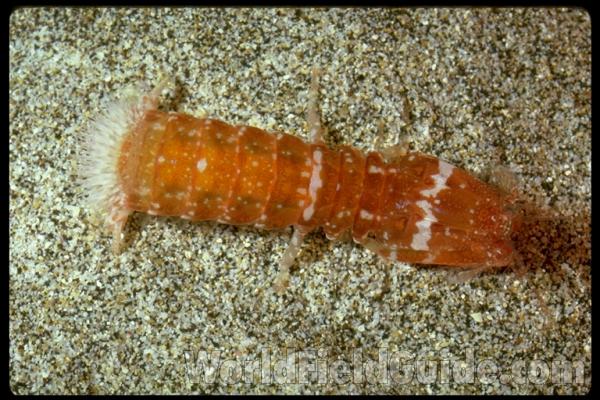SPECIES INFO
Orange mantis shrimp (Gonodactylus guerinii to Echinosquilla guerinii) is found from the Seychelles (near Madagascar in the western Indian Ocean) east through Indonesia to Japan, Hawaii, and Fiji. The image taken by Alex Kerstitch shows this or a very similar species is found as far east as Panama.Mantis shrimp family (Family Gonodactylidae in the order Stomatopoda) contains some very colorful species of marine coral reef shrimp. This family is found in all warm oceans of the world. These shrimps have large segmented tails and a smaller thorax. The front pinchers have the movable part toward the front in contrast to lobsters and crayfish that have the movable part to the rear or inside.
Mantis shrimps (Order Stomatopoda) are quite unlike most other crustaneans. They have a jointed head that can move separate from the body. This movable head supports eyes and antenna. They also have large sharp front legs for grabbing prey. This is a well established group of shrimp. There are over 65 species in the Caribbean, Bahama, and Florida region.
Crustaceans (Class Crustacea) is a large class of mostly aquatic animals. Although many species are marine, there is a large number of small freshwater species and a few species of larger freshwater crayfish. There are many subdivisions to the Crustacea including such diverse animals as water fleas, fish lice, barnacles, crabs, shrimp, and crayfish. There are probably over 26,000 species in this class.
Jointed Legged Animals (Phylum Arthropoda) make up the largest phylum. There are probably more than one million different species of arthropods known to science. It is also the most successful animal phylum in terms of the total number of living organisms.
Butterflies, beetles, grasshoppers, various insects, spiders, and crabs are well-known arthropods.
The phylum is usually broken into the following five main classes:
Arachnida: - Spiders and Scorpions
Crustacea: - Crabs and Crayfish
Chilopoda: - Centipedes
Diplopoda: - Millipedes
Insecta: - Insects
There are several other "rare" classes in the arthropods that should be mentioned. A more formal list is as follows:
Sub Phylum Chelicerata
C. Arachnida: - Spiders and scorpions
C. Pycnogonida: - Sea spiders (500 species)
C. Merostomata: - Mostly fossil species
Sub Phylum Mandibulata
C. Crustacea: - Crabs and crayfish
Myriapod Group
C. Chilopoda: - Centipedes
C. Diplopoda: - Millipedes
C. Pauropoda: - Tiny millipede-like
C. Symphyla: - Garden centipedes
Insect Group
C. Insecta: - Insects
The above list does not include some extinct classes of Arthropods such as the Trilobites.
Animal Kingdom contains numerous organisms that feed on other animals or plants. Included in the animal kingdom are the lower marine invertebrates such as sponges and corals, the jointed legged animals such as insects and spiders, and the backboned animals such as fish, amphibians, reptiles, birds, and mammals.


